Experimental Study on Gas–Liquid–Solid Interaction Characteristics in the Launch Tube
Abstract
:1. Introduction
2. Experimental Device
3. Experimental Results and Discussions
3.1. Influence of a Single Groove Area
3.2. Influence of the Maximum Pressure
3.3. Influence of the Groove Number
4. Conclusions
- (1)
- When the total gas energy is certain, increasing the area of a single groove from 6.25 mm2 to 11.25 mm2, the gas-curtain displacement grows by 47.5%, and the projectile’s speed reduces by 34.1%. Within a certain range of grooves (4 to 8), increasing the groove numbers can improve the drainage capacity by 36.0%. However, the excessive number of grooves not only has little effect on the improvement of the drainage capacity of the gas curtain, but also reduces the energy distribution effect, that is, the vehicle’s speed is reduced by 53.8%.
- (2)
- Under the same injection structure, increasing the maximum pressure from 9.9 MPa to 18.2 MPa, that is, increasing the total energy of gas, can improve the drainage capacity of the gas curtain by 29.6%. Meanwhile, the energy distribution effect is also improved only by 10.0%. However, as the amount of gas flowing into the projectile front increases, so does the pressure in front of the projectile, which not only promotes the growth of gas-curtain displacement, but also increases the launch resistance. However, as the amount of gas flowing into the projectile front increases, so does the pressure in front of the projectile, promoting not only the growth of gas-curtain displacement but also increasing launch resistance.
- (3)
- The influence of a single parameter (the area of a single groove, maximum pressure, or groove numbers) on the gas-curtain displacement and projectile velocity is different.
Author Contributions
Funding
Institutional Review Board Statement
Informed Consent Statement
Data Availability Statement
Conflicts of Interest
References
- Zhou, L.; Yu, Y. Study on interaction characteristics between multi gas jets and water during the underwater launching process. Exp. Therm. Fluid Sci. 2017, 83, 200–206. [Google Scholar] [CrossRef]
- Hu, Y.; Yu, Y. Drainage characteristics of circumferential multi-strand wall combustion gas jets in a liquid-filled circular tube. Acta Armamentarii 2020, 41, 2417–2423. [Google Scholar]
- Gong, Z.; Lu, C.; Li, J. The gas jet behavior in submerged Laval nozzle flow. J. Hydrodyn. 2017, 29, 1035–1043. [Google Scholar] [CrossRef]
- Kang, H.; Baek, S.; Ahn, B. Conceptual design of high-speed underwater jet engine using high concentration of hydrogen peroxide. Ocean Eng. 2018, 153, 193–200. [Google Scholar] [CrossRef]
- Degtiar, V.G.; Pegov, V.I.; Moshkin, I.Y. Mathematical modeling of the processes of heat and mass transfer of hot gas jets with fluid during underwater rocket launches. High Temp. 2019, 57, 707–711. [Google Scholar] [CrossRef]
- Zhang, X.; Li, S.; Yang, B. Flow structures of over-expanded supersonic gaseous jets for deep-water propulsion. Ocean Eng. 2020, 213, 107611. [Google Scholar] [CrossRef]
- Xiang, M.; Zhao, X.; Zhou, H. Transient dynamic analysis for the submerged gas jet in flowing water. Eur. J. Mech. B/Fluids 2021, 85, 351–360. [Google Scholar] [CrossRef]
- Yu, X.; Wang, Y.; Huang, C. Unsteady characteristics of ventilated cloud cavity around symmetrical bodies. J. Ship Mech. 2014, 18, 499–506. [Google Scholar]
- Zou, W.; Liu, H.; Xue, L. Three-dimensional ventilated supercavity on a maneuvering trajectory. Ocean Eng. 2016, 122, 97–104. [Google Scholar] [CrossRef]
- Wang, Z.; Huang, B.; Zhang, M. Experimental and numerical investigation of ventilated cavitating flow structures with special emphasis on vortex shedding dynamics. Int. J. Multiph. Flow 2017, 98, 79–95. [Google Scholar] [CrossRef]
- Xu, H.; Luo, K.; Dang, J. Numerical investigation of supercavity geometry and gas leakage behavior for the ventilated supercavities with the twin-vortex and the re-entrant jet modes. Int. J. Nav. Archit. Ocean Eng. 2021, 13, 628–640. [Google Scholar] [CrossRef]
- Shao, S.; Li, J.; Yoon, K. Probing into gas leakage characteristics of ventilated supercavity through bubbly wake measurement. Ocean Eng. 2022, 245, 110457. [Google Scholar] [CrossRef]
- Weiland, C.J.; Vlachos, P.P.; Yagla, J.J. Concept analysis and laboratory observations on a water piercing missile launcher. Ocean Eng. 2010, 37, 959–965. [Google Scholar] [CrossRef]
- Cao, W.; Liu, H.; Wang, C. The effect of gas jet speed on the motion process of the underwater vehicle vertical launching by using gas curtain. Eng. Mech. 2013, 30, 288–292. [Google Scholar]
- Wang, Y.; Yuan, X.; Zhang, Y. On the effect of bubble elasticity to sub-launch process using concentric canister launcher. Chin. J. Comput. Mech. 2013, 30, 313–318. [Google Scholar]
- Li, T.; Hu, J.; Cao, X. Pinch-off process of underwater annular-nozzled gas jet. CIESC J. 2017, 68, 4565–4575. [Google Scholar]

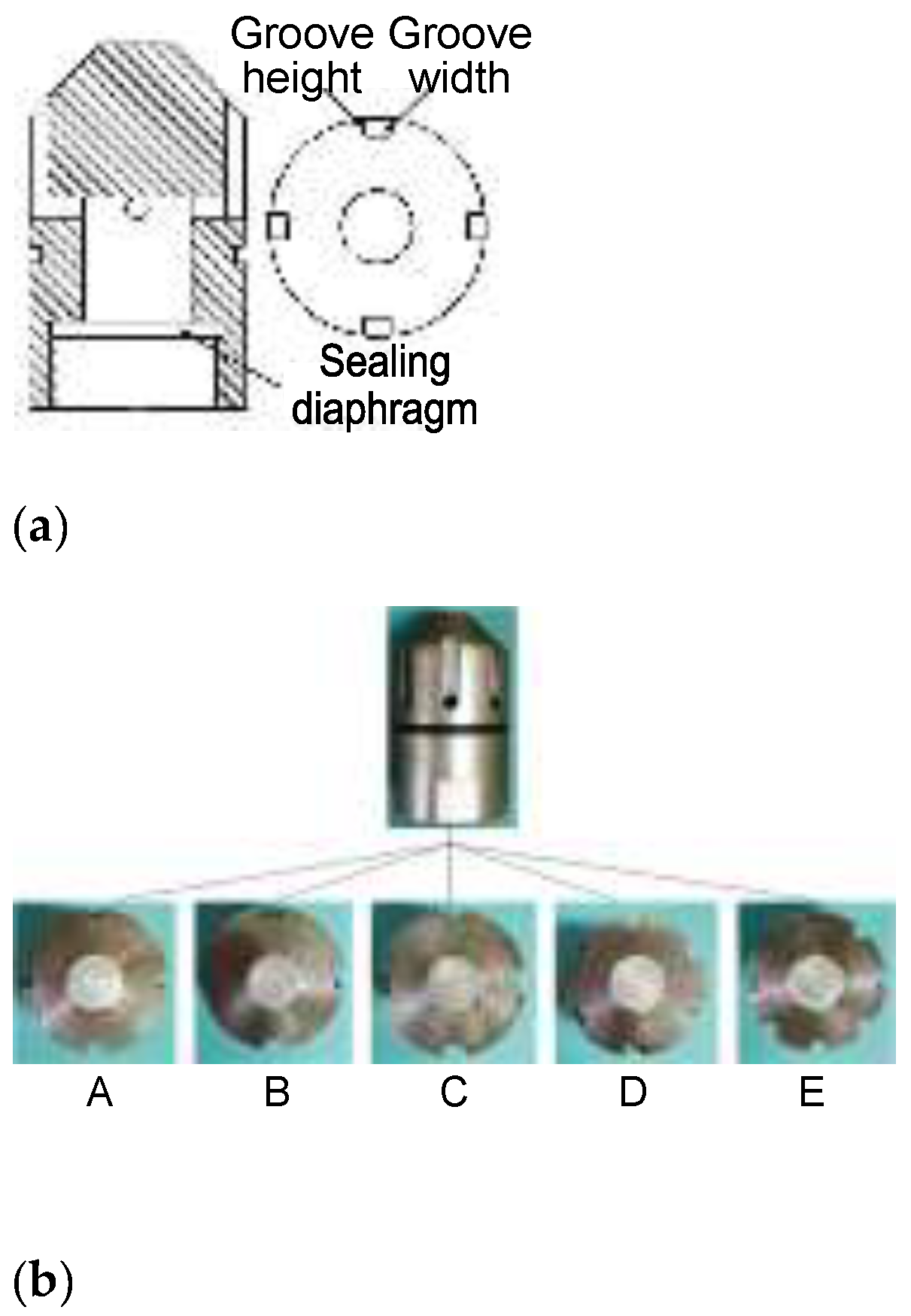
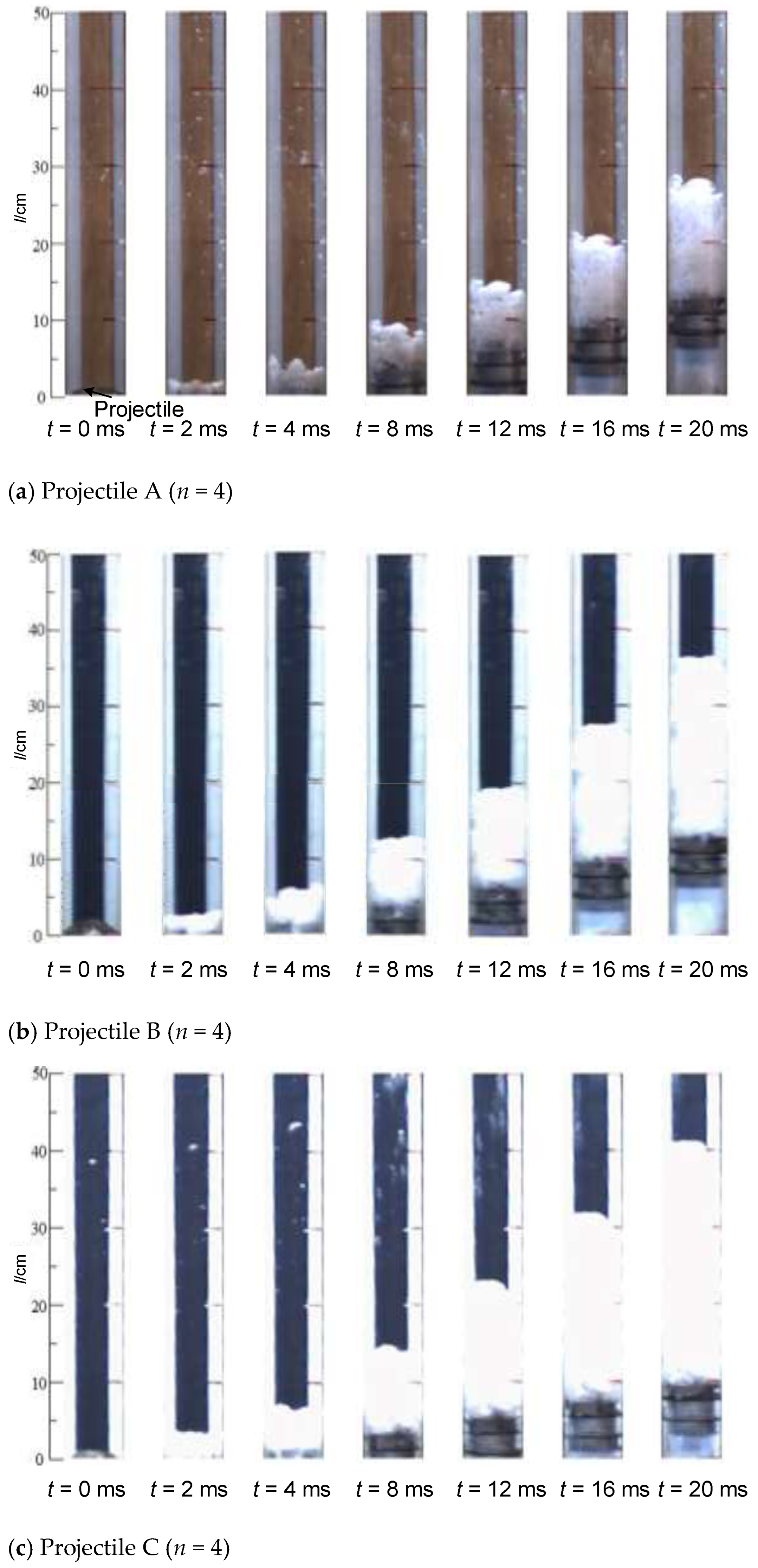
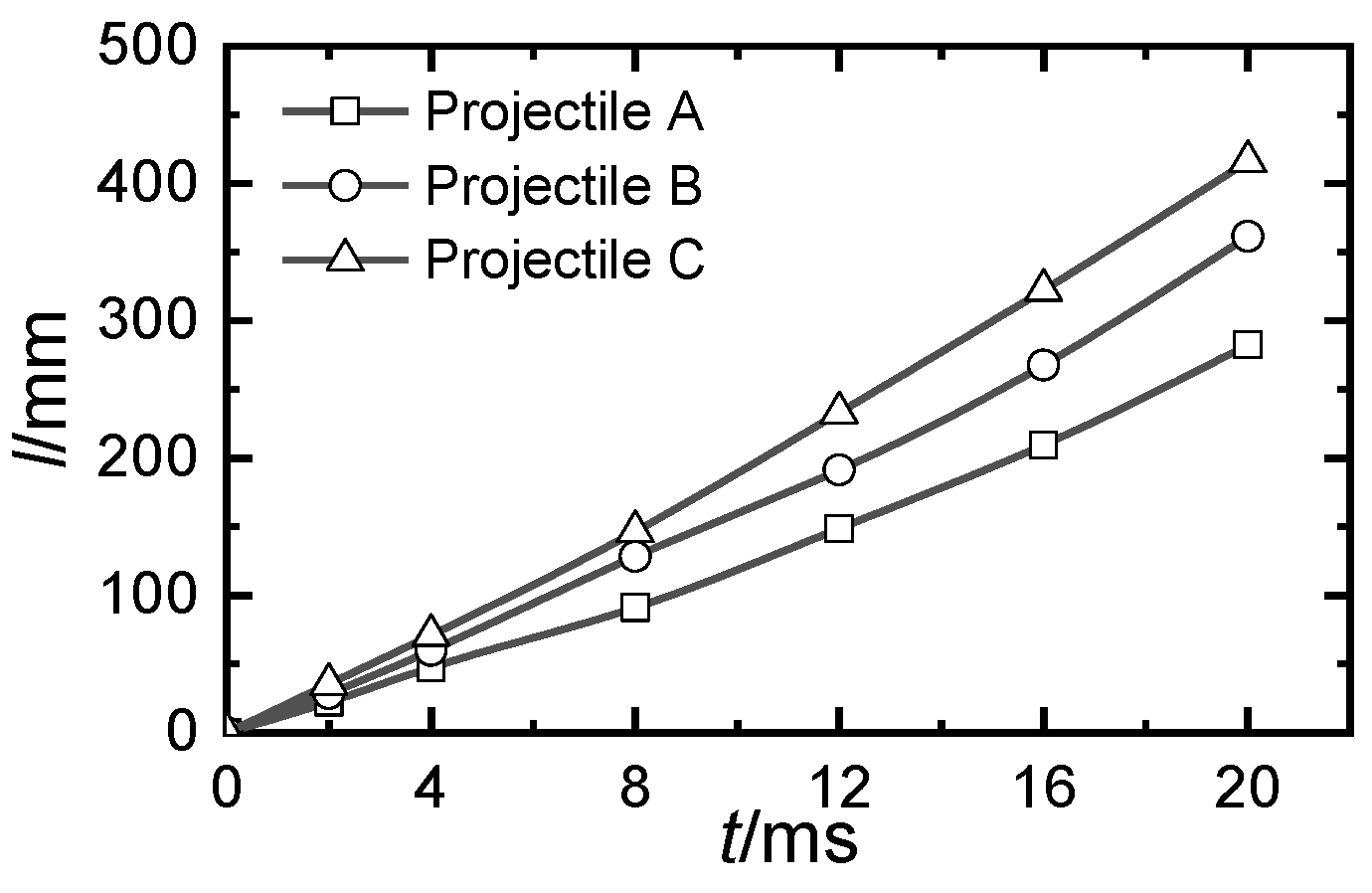
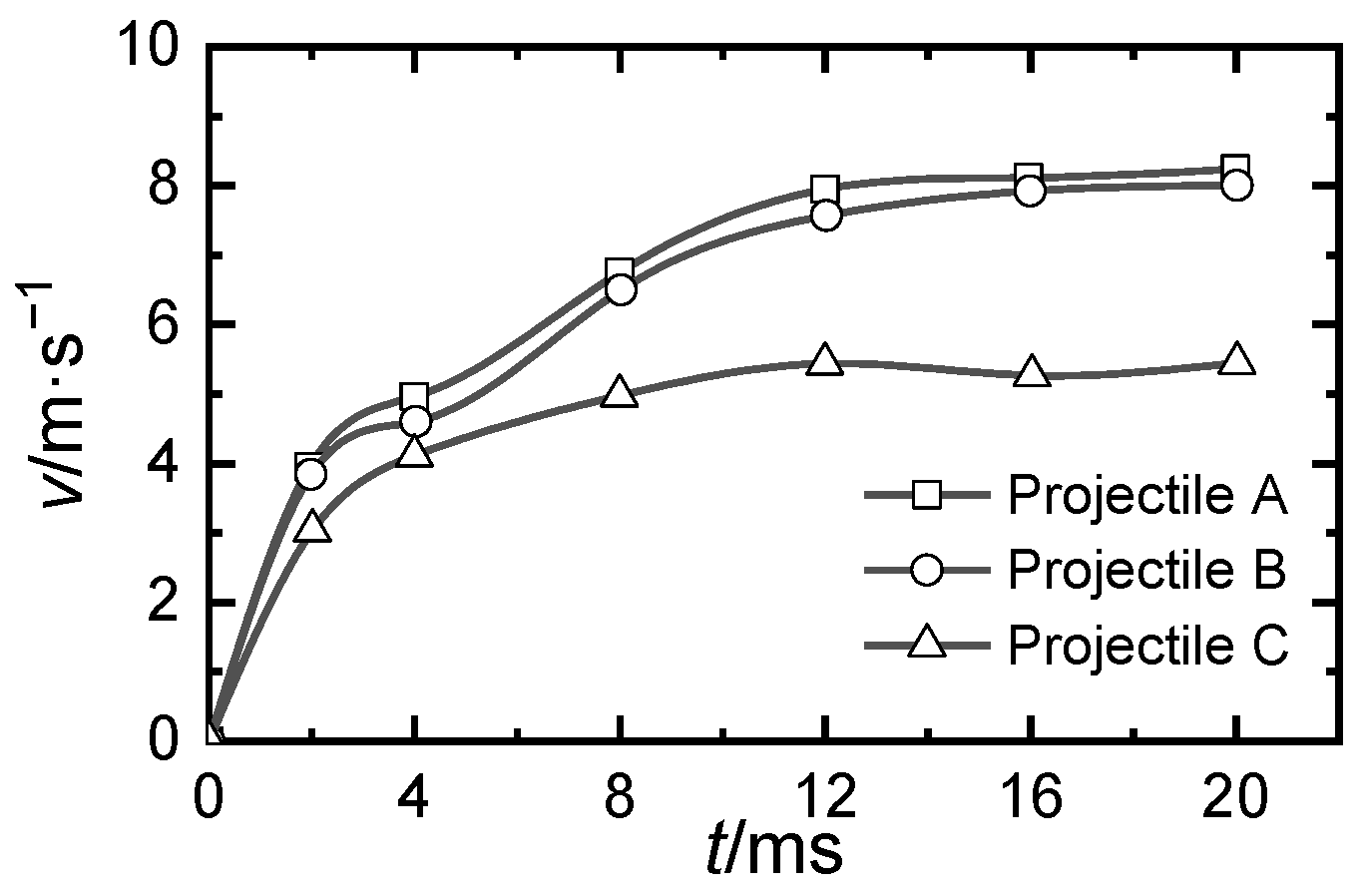
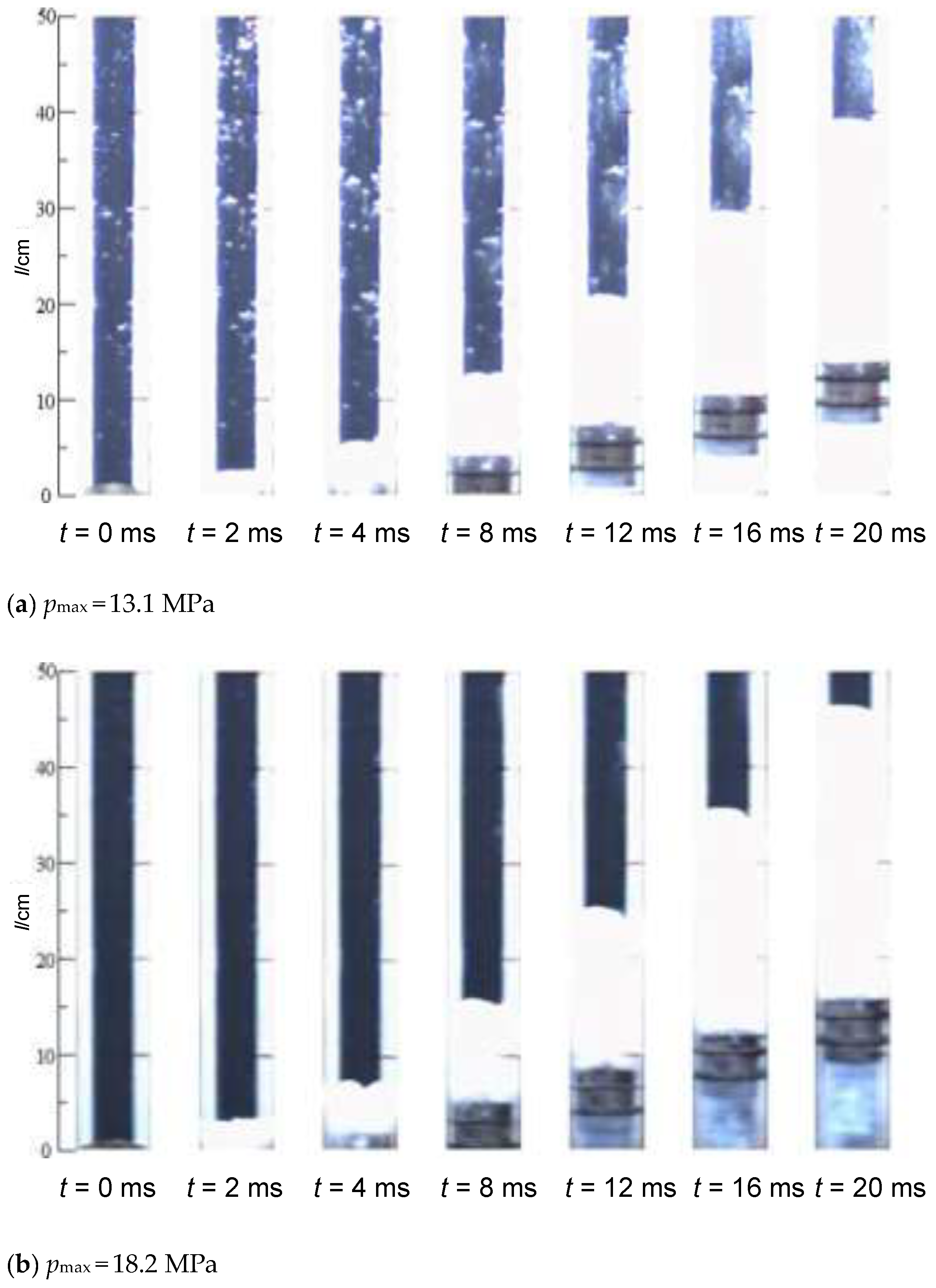
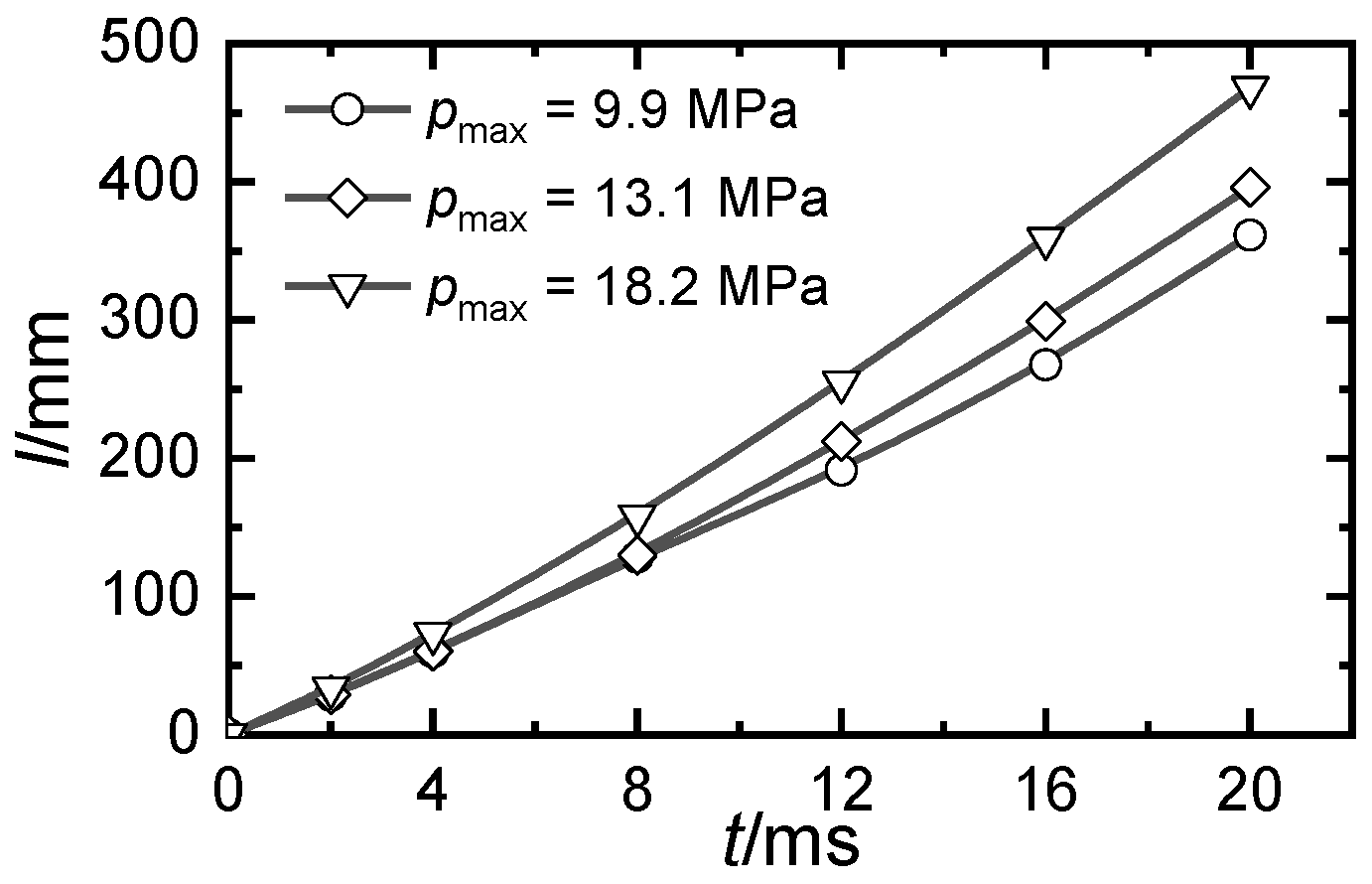
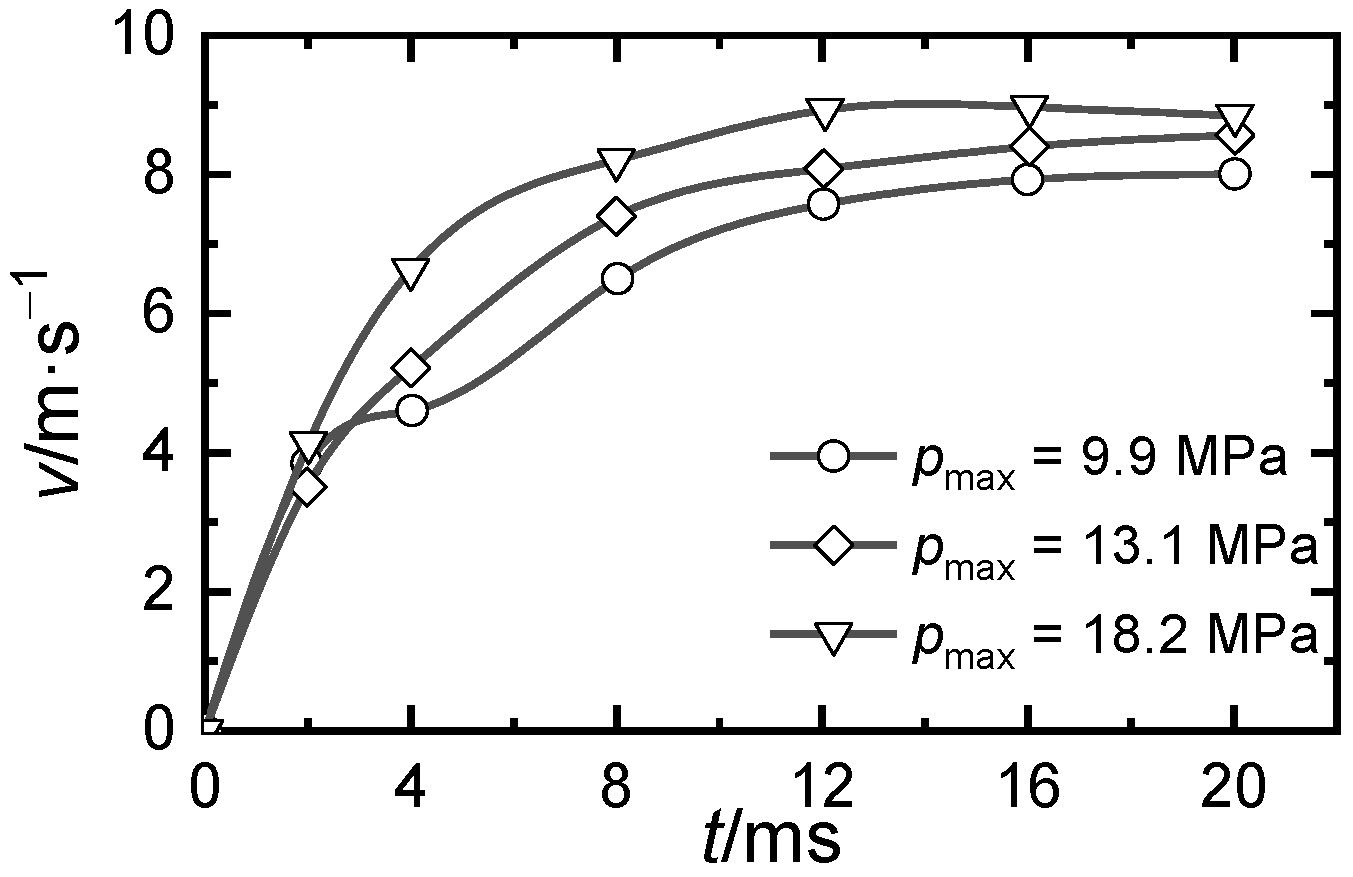
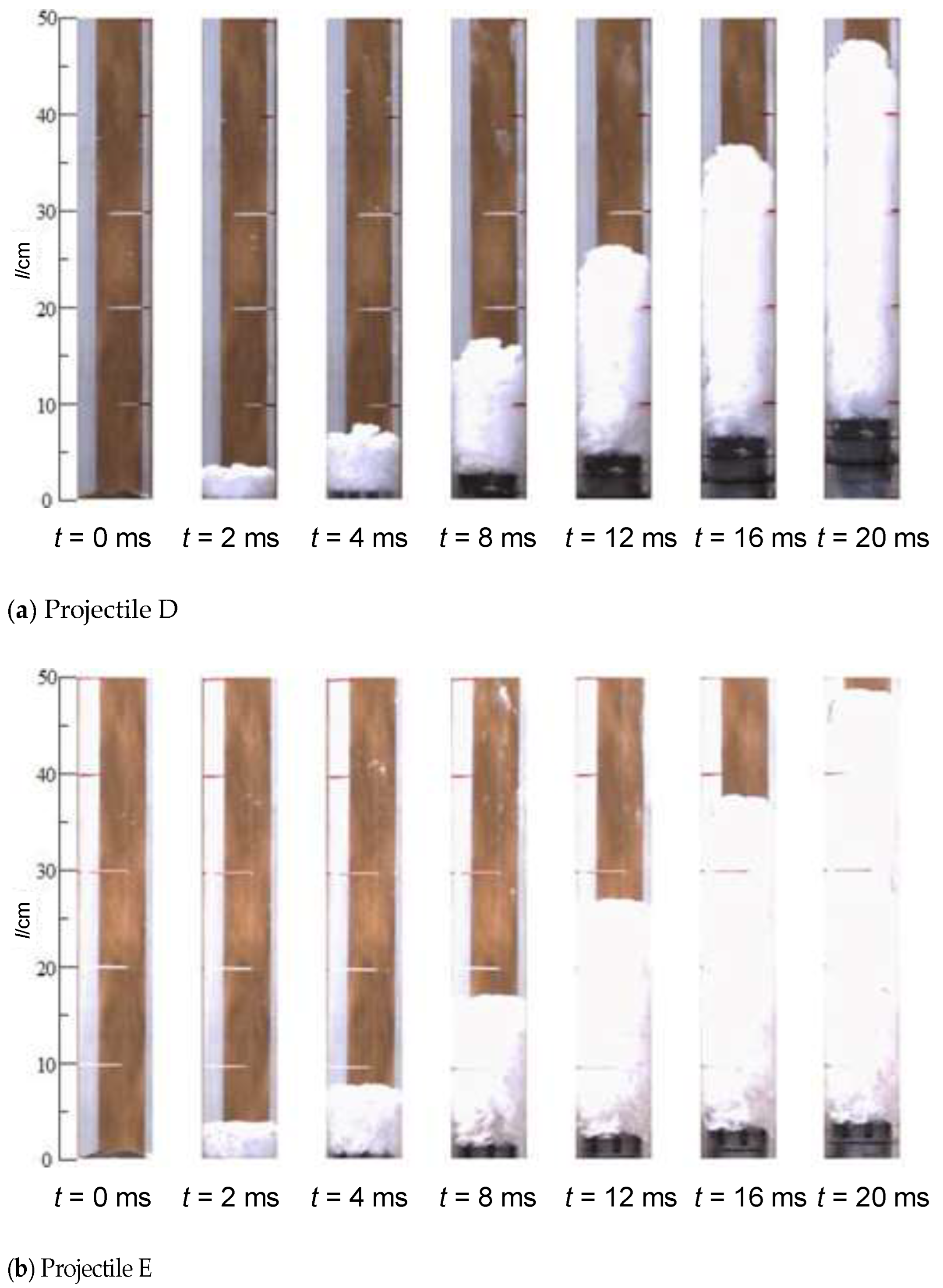

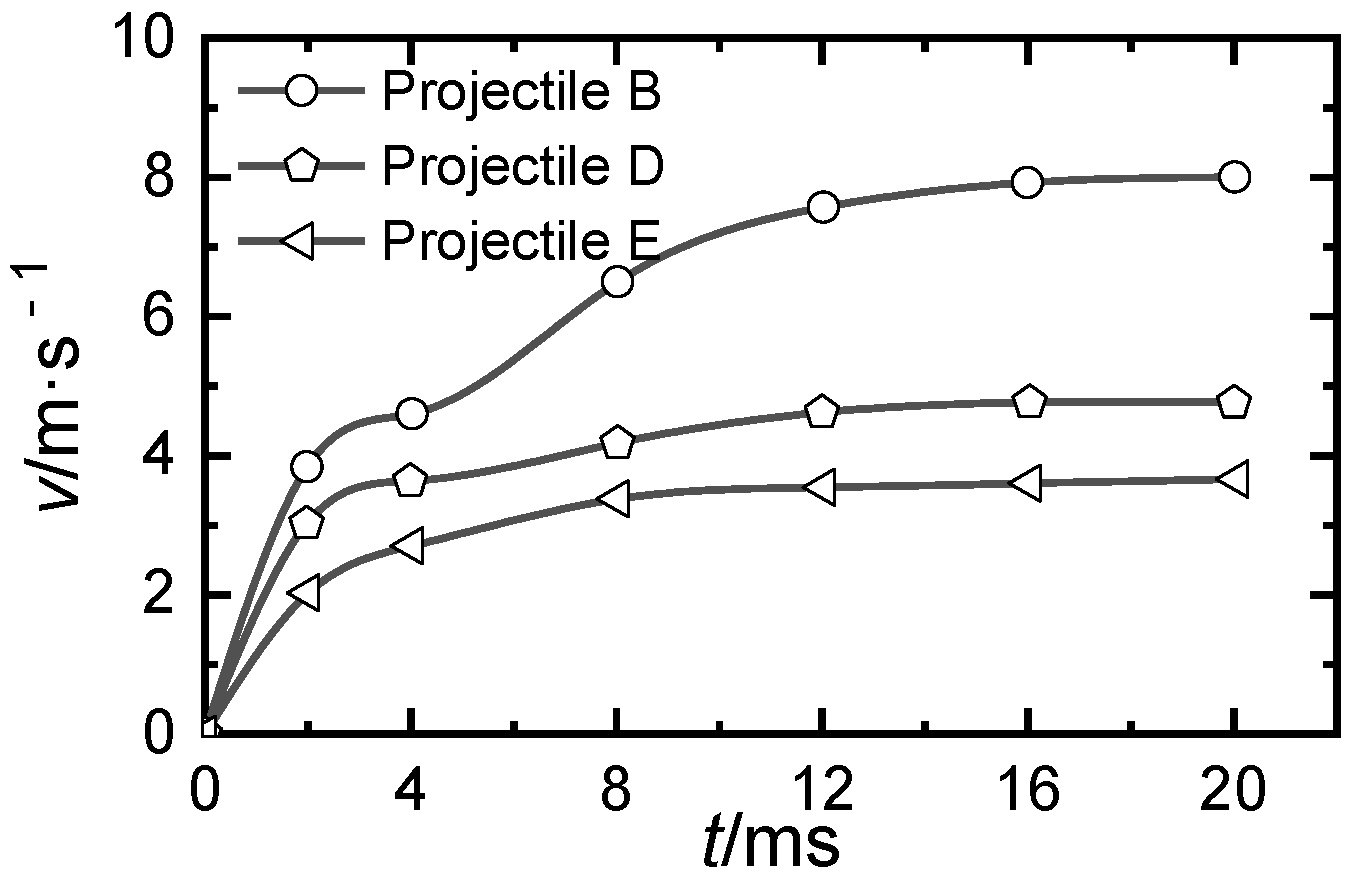
| Types | w/mm | h/mm | s/mm2 | n |
|---|---|---|---|---|
| A | 2.5 | 2.5 | 6.25 | 4 |
| B | 3.5 | 2.5 | 8.75 | 4 |
| C | 4.5 | 2.5 | 11.25 | 4 |
| D | 3.5 | 2.5 | 8.75 | 6 |
| E | 3.5 | 2.5 | 8.75 | 8 |
Publisher’s Note: MDPI stays neutral with regard to jurisdictional claims in published maps and institutional affiliations. |
© 2022 by the authors. Licensee MDPI, Basel, Switzerland. This article is an open access article distributed under the terms and conditions of the Creative Commons Attribution (CC BY) license (https://creativecommons.org/licenses/by/4.0/).
Share and Cite
Zhang, X.; Yu, Y.; Hu, Y. Experimental Study on Gas–Liquid–Solid Interaction Characteristics in the Launch Tube. J. Mar. Sci. Eng. 2022, 10, 1239. https://doi.org/10.3390/jmse10091239
Zhang X, Yu Y, Hu Y. Experimental Study on Gas–Liquid–Solid Interaction Characteristics in the Launch Tube. Journal of Marine Science and Engineering. 2022; 10(9):1239. https://doi.org/10.3390/jmse10091239
Chicago/Turabian StyleZhang, Xinwei, Yonggang Yu, and Yubo Hu. 2022. "Experimental Study on Gas–Liquid–Solid Interaction Characteristics in the Launch Tube" Journal of Marine Science and Engineering 10, no. 9: 1239. https://doi.org/10.3390/jmse10091239





